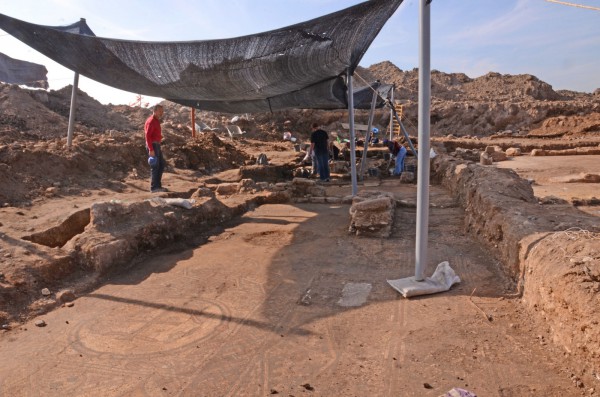
This pristine church mosaic was recently uncovered near Tel Aviv. (Photo credit: Yoli Shwartz, Dr. Davida Dagan, courtesy of the Israel Antiquities Authority)
Prior to the construction of a new neighborhood some 30 miles (50 kilometers) south of Tel Aviv at Moshav Aluma, the Israel Antiquities Authority (IAA) has unearthed a remarkable 1,500-year-old Byzantine church with intricate mosaics.
Because all new construction must begin with a salvage excavation, construction came to a halt when Israeli archaeologists discovered the church.
“The building consists of a central hall with two side aisles divided by marble pillars. At the front of the building is a wide open courtyard paved with a white mosaic floor, and with a cistern,” said IAA excavations director Daniel Varga. (IAA)
The church likely served as the worship center for Christians in the surrounding communities.
In the main hall (nave) of the impressive 22- by 12-meter (72- by 39-foot) basilica, an elaborate mosaic complete with colored geometric and botanical designs was discovered. The mosaic’s 40 medallions depict a variety of animals that include zebra, leopard, turtle, wild boar, and birds.
The mosaics of the two long halls flanking the main hall also contain geometric and botanical designs, as well as Christian symbols.
At the center of the hall (narthex) off of the building’s open courtyard (atrium) is a 12-row Greek inscription that includes the names Miryam (Mary) and Yeshua (Jesus).
One of the mosaics that the archaeologists uncovered was a Christogram (the first two letters of the Greek word Christ) with an alpha and an omega surrounded by birds. (Discovery News)
Although archaeologists have found evidence of a flourishing Byzantine culture at Aluma, this is the first Byzantine church uncovered in the area.
The church, which will be covered over once again and preserved, was open to the public last Thursday and Friday.
The pristine mosaics will be removed and placed in a museum before the site is covered again.











